
Visit Highgate

VISIT
HIGHGATE
Free printed copies of this map can be obtained from The Highgate Society, The HLSI, The Village Deli (all in South Grove),The Gatehouse Pub and Highgate Cemetery. Please note the location numbers on the information boards do not correspond with the green numbers on the map.
Places of interest in Highgate
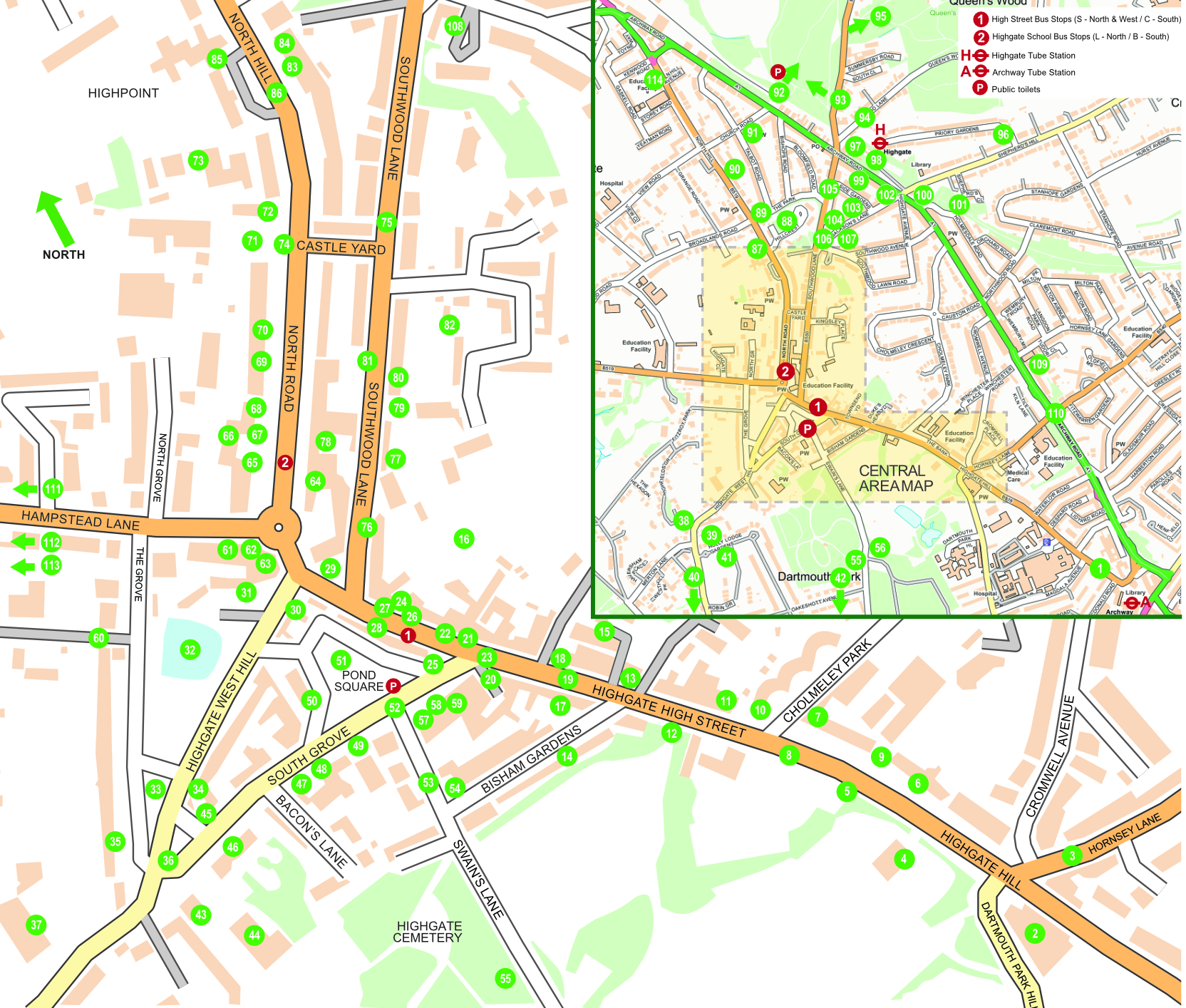
Highgate originated as the southeastern tollgate into the mediæval Bishop of London’s 1,000-acre Deer Park, from which its name probably derives. The Church owned the land from the 7th to the 19th century, when it was sold for development. The village started to grow in the 15th century; by the 17th century it was a fashionable place, with large mansions, and by the 18th century was a thriving village. The Archway Road was built in 1813 to bypass Highgate Hill. Highgate was the last stop on the droving road to London’s Smithfield meat market; more than 40 pubs and inns have come and gone over the years. The High Street retains traces of its ancient inn yards.
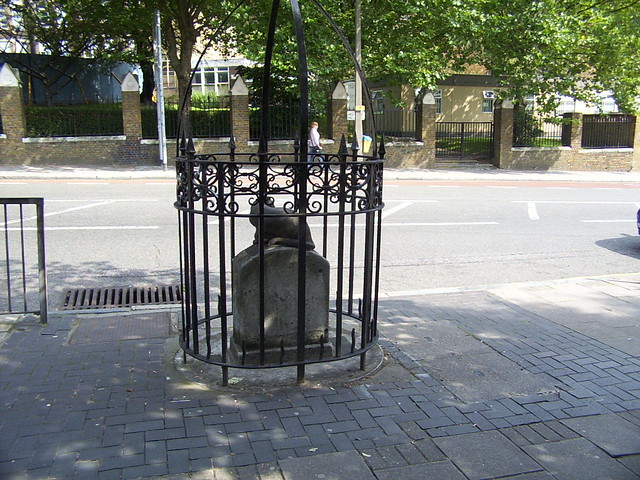
- A short distance up Highgate Hill from Archway Station is the Whittington Stone, recalling one of England’s most cherished legends: the spot where Dick Whittington and his cat, about to return to Gloucestershire in disillusionment, heard the Bow Bells telling him to “turn again” and become “thrice Lord Mayor of London”.
The real Sir Richard Whittington (c.1354–1423) was a wealthy merchant and Mayor of London three times. In 1964 the cat was placed near the hospital that bears his master’s name.. Show on Google Maps - Joseph’s Retreat is the Order of Passionists’ HQ in England. They built a chapel here in 1858, on the site of the Black Dog Inn; this building, by Albert Vicars, was consecrated in 1885.
- Hornsey Lane, an ancient road, formerly Maiden Lane. Historic buildings at the Highgate end include the 17th century No. 20.
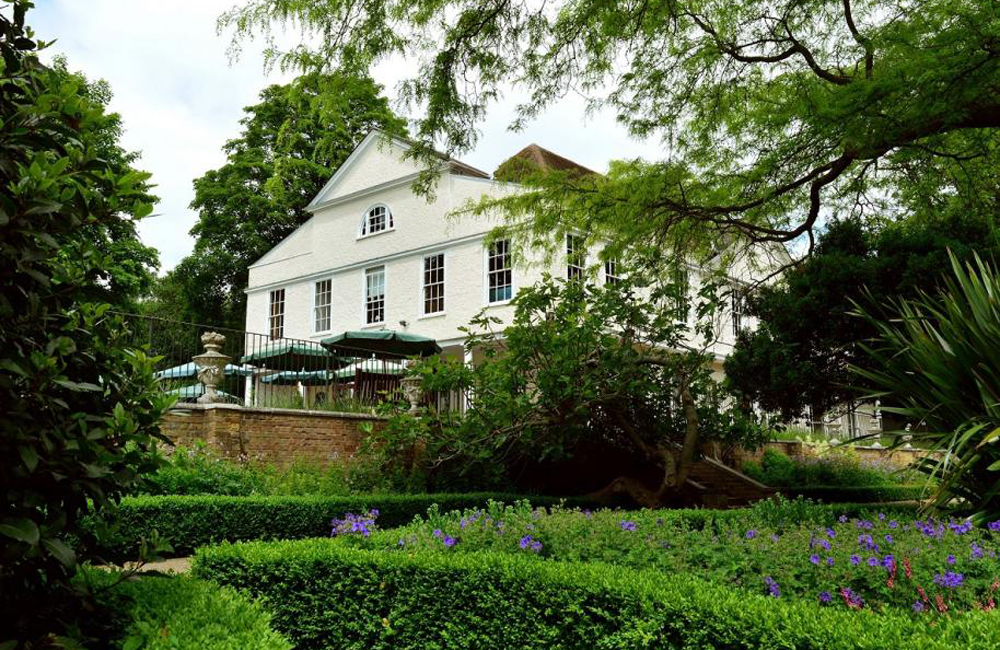
- Lauderdale House, built c.1580, probably for merchant Sir Richard Martin, Mayor of London; remodelled in 1760. During the 1660s it was owned by the Earl of Lauderdale (the ‘L’ of CABAL); visitors included Charles II and Samuel Pepys, but the claim that Nell Gwynn was installed there by Charles II is unsubstantiated. Its last owner was printing magnate Sir Sydney Waterlow, who gave it, with 29 acres of gardens, now Waterlow Park, to the public in 1889. It is now a thriving local cultural centre. The House features classical music, jazz and poetry along with children’s shows for all age groups. In the summer the lawn is used for a variety of entertainment including music, drama and comedy. The sundial is level with the top of the dome of St. Paul’s Cathedral.
- A wall plaque marks the site of the cottage said to have been poet Andrew Marvell’s (1621-78), demolished in 1867.
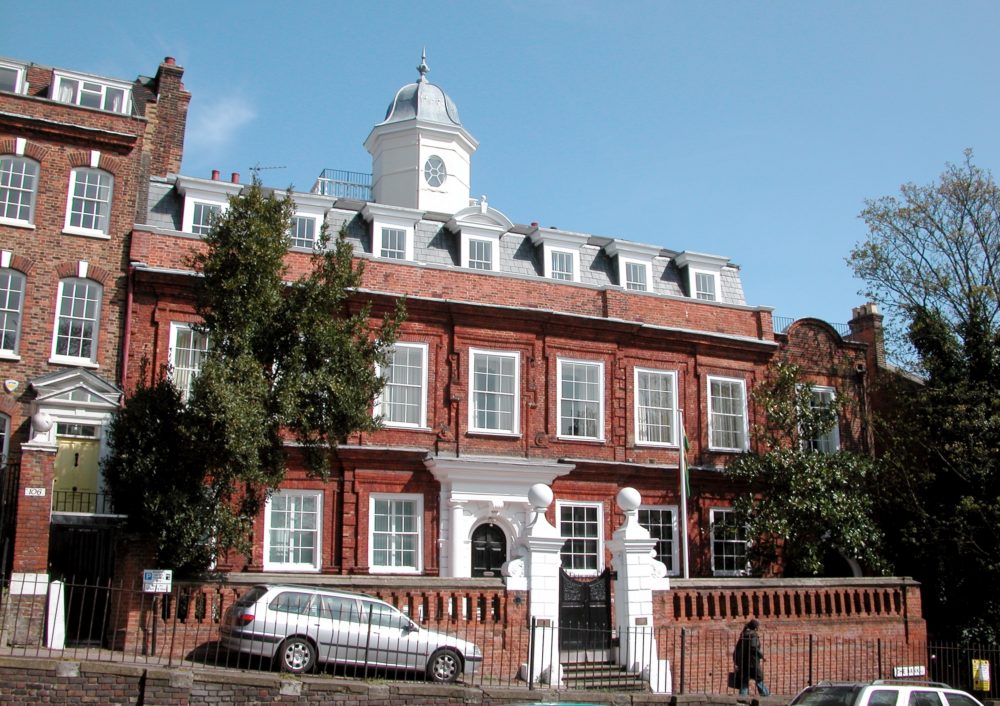
- Cromwell House, built 1637-8 for Richard Sprignell, one of London’s finest 17th century houses, Grade I Listed, with elaborate interiors. In 1675 it was purchased by Jewish merchant Alvaro da Costa, the first property in England to be owned by Jews after their re-admission in 1656. A school from 1830, it was damaged by fire in 1865, was a convalescent home 1869-1924 and is now the Ghana High Commission. It has no connection with Oliver Cromwell, the name dating to c.1833.
- The Bank is fronted by fine 17th and 18th century houses. The picturesque 19th century gate house for the original 1770s Cholmeley Lodge (demolished 1934), survives by the corner of Cholmeley Park.
- Highgate Hill was the site of Europe’s first cable-car. Built 1884 by Andrew Smith Hallidie, designer of the San Francisco Cable Car system, it was replaced in 1909, after several accidents, by a tram, and by a bus in 1939.
- Channing School for girls, founded 1885 by Matilda and Emily Sharp for the daughters of Unitarian Ministers; named after American Unitarian Minister William Ellery Channing (1780-1842).
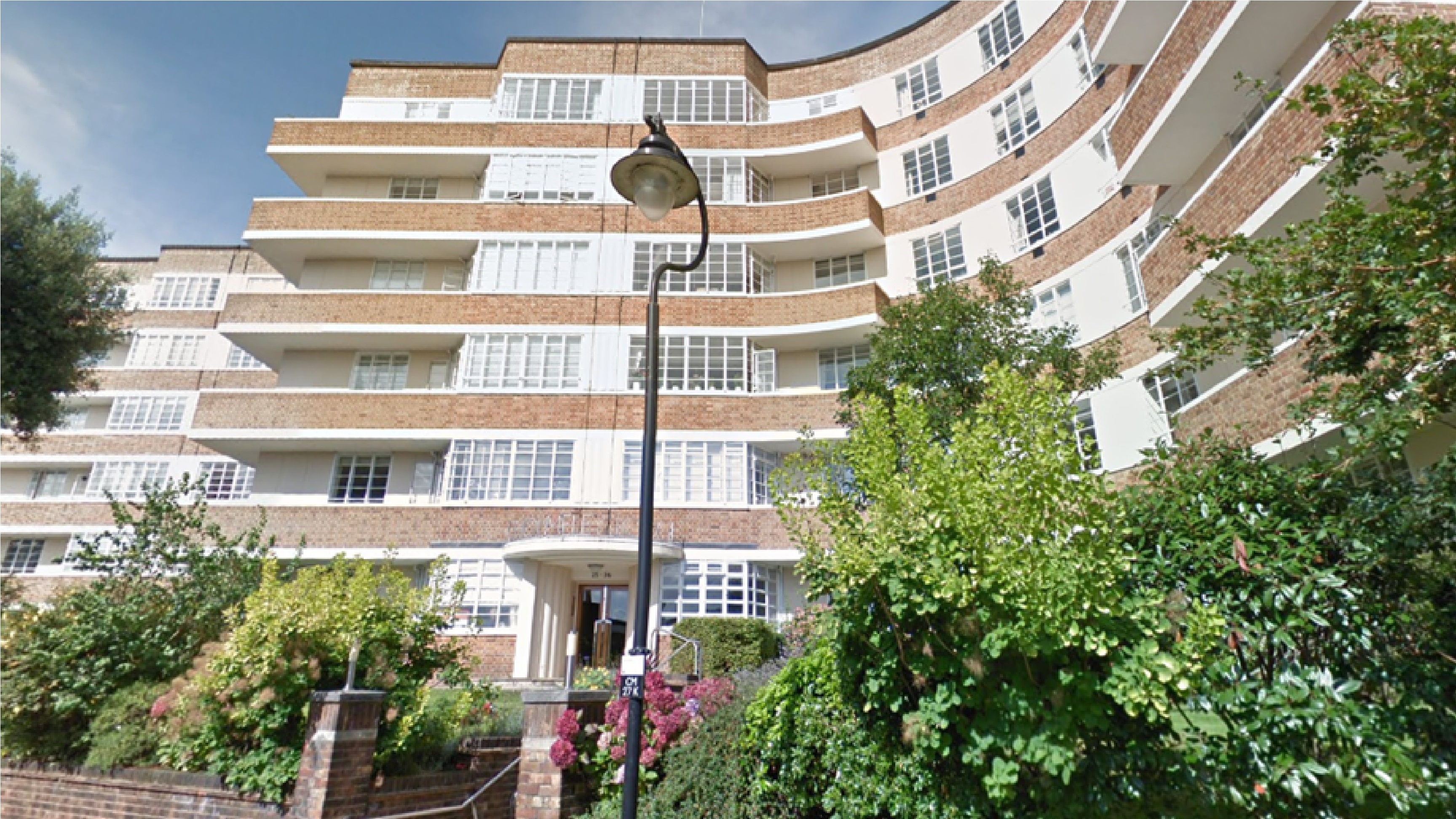
- Cholmeley Lodge, by architect Guy Morgan, a fine 1930s Art Deco block.
- Ivy House and Northgate House, 128 and 130 Highgate Hill, an important pair of 1660s houses and the White House, 10 Highgate High Street, dates from 1703.
- Waterlow Park was dedicated in 1889 by industrialist and philanthropist Sir Sydney Waterlow as “a garden for the gardenless”. His home, Fairseat, is now Channing Junior School. His statue, in the park, is the only one in London showing a person carrying an umbrella!
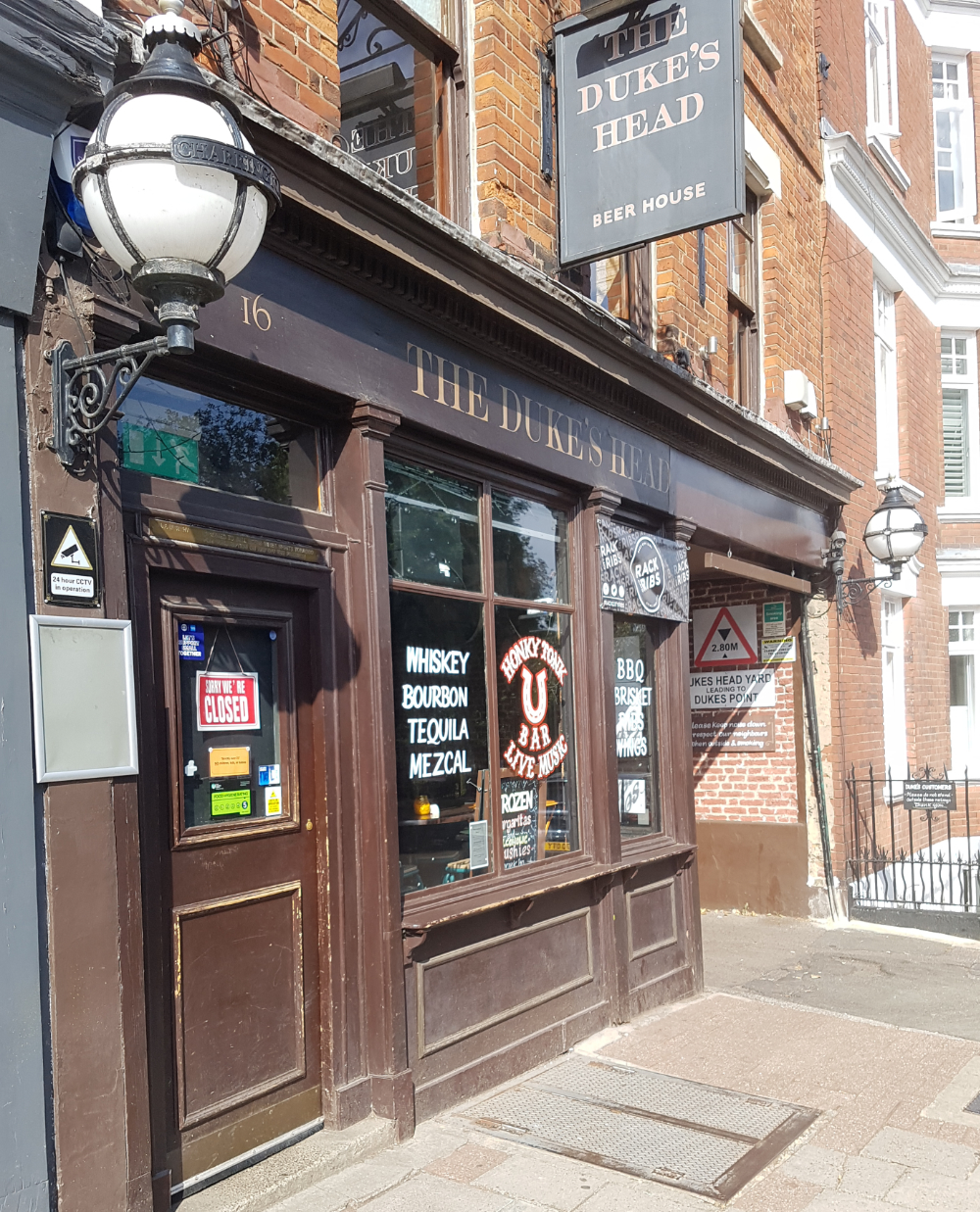
- The popular village pub The Dukes Head now features music on a regular basis.
- Bisham Gardens, built c.1891 on the site of Bisham House, the home of Captain Peter Heywood, who was a young Midshipman on HMS Bounty during the famous 1789 mutiny.
- At the north end of Broadbent Close is an extraordinary Folly by local builder Thomas Townshend (42 Highgate High Street 1826-51), probably from oddments from the demolition of 17th century mansion Ashurst House.
- The “Highgate Bowl”, behind the High Street, is an important survival of rural Highgate, fiercely defended against development by local people for five decades, now it houses an arts and environmental centre.
- 17-23 Highgate High Street, a fine row of c. 1700 Grade II* houses.
- 42 Highgate High Street, probably by local builder Thomas Townsend, c.1830-40. Its entrance was originally the door of Ashurst House, the c.1675 mansion of Sir William Ashurst, Lord Mayor of London, demolished c.1830.
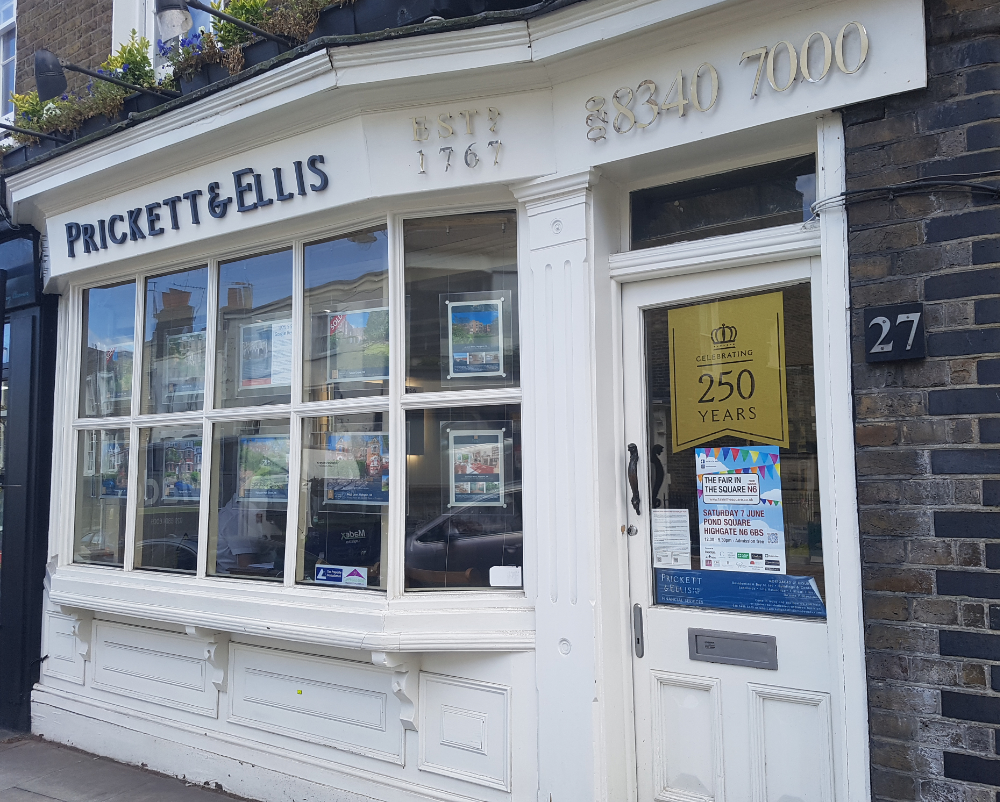
- 27 Highgate High Street – Prickett & Ellis, the world’s oldest Estate Agents, founded in 1767.
- The Angel Inn, built c.1500, rebuilt in 1928. Its stable yard is now a gated residential enclave.
- 58-60 Highgate High Street, an important 19th century shopfront with original steps. The weatherboarded front and sack chute was a corn chandler’s, a remarkable survival for London.
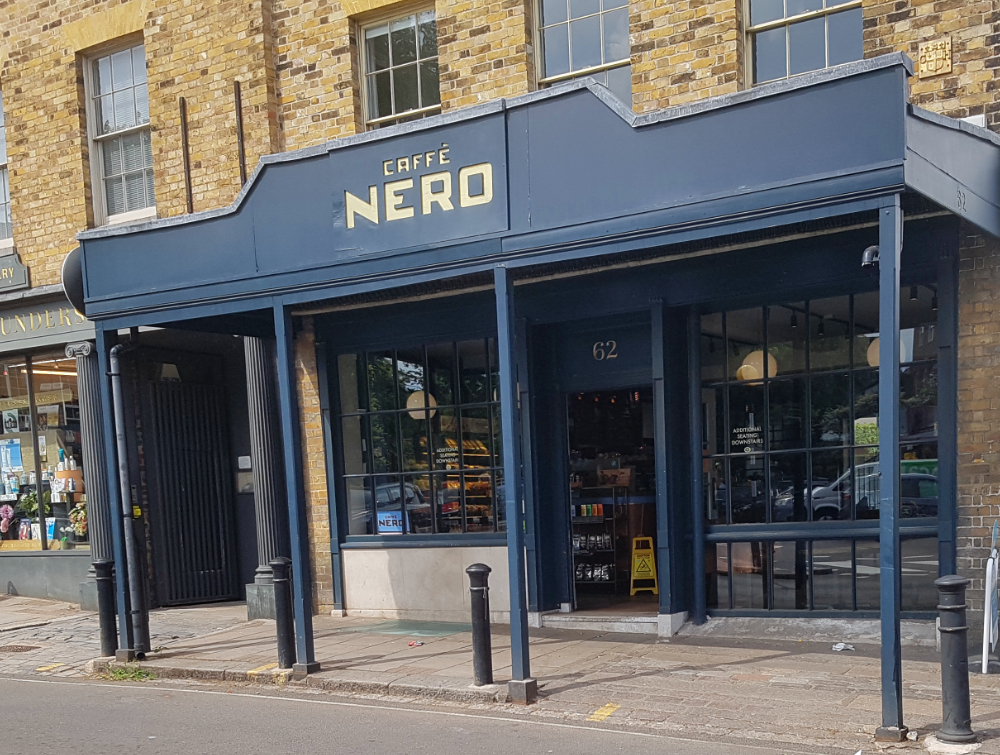
- The canopy of 62 Highgate High Street is a modern copy of the 19th century butcher’s shop canopy,
demolished by a bus some years ago. - Though a busy traffic route, Highgate High Street retains its 18th-19th century village character and many narrow mediæval plots. The 1960s campaign to fight proposals to demolish the High Street and re-route the A1 through the village made national headlines and led to the founding of the Highgate Society, which is still active in monitoring planning and other local issues.
- 64 Highgate High Street, Bailey & Saunders, has been a chemist’s since 1832. The current shopfront is an replica of the original, destroyed in the 1990s by a previous owner.
- Occupied by a quaint blacksmiths from the 1660s to c.1900, it is hoped that this former bus turnaround
area will soon become a landscaped pedestrian link between the High Street and Pond Square.
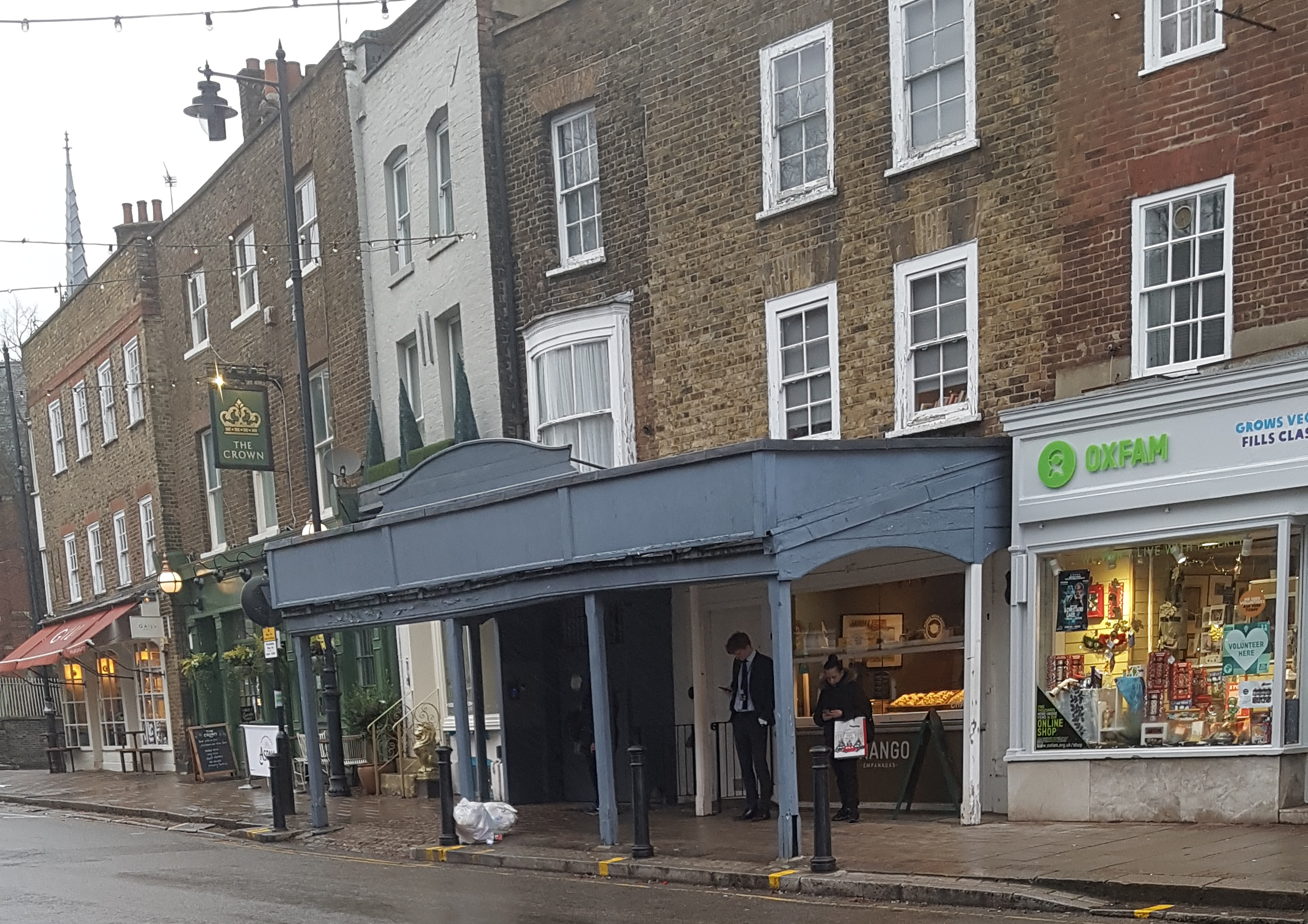
- The canopy of 82 Highgate High Street is a remarkable survival. A butchers and slaughterhouse from 1813 until the 1960s, it still retains some of the original butchers’ fittings.
- 88 Highgate High Street, a pub since 1730, formerly the Rose and Crown. It reopened in 2024 as “The Crown”.
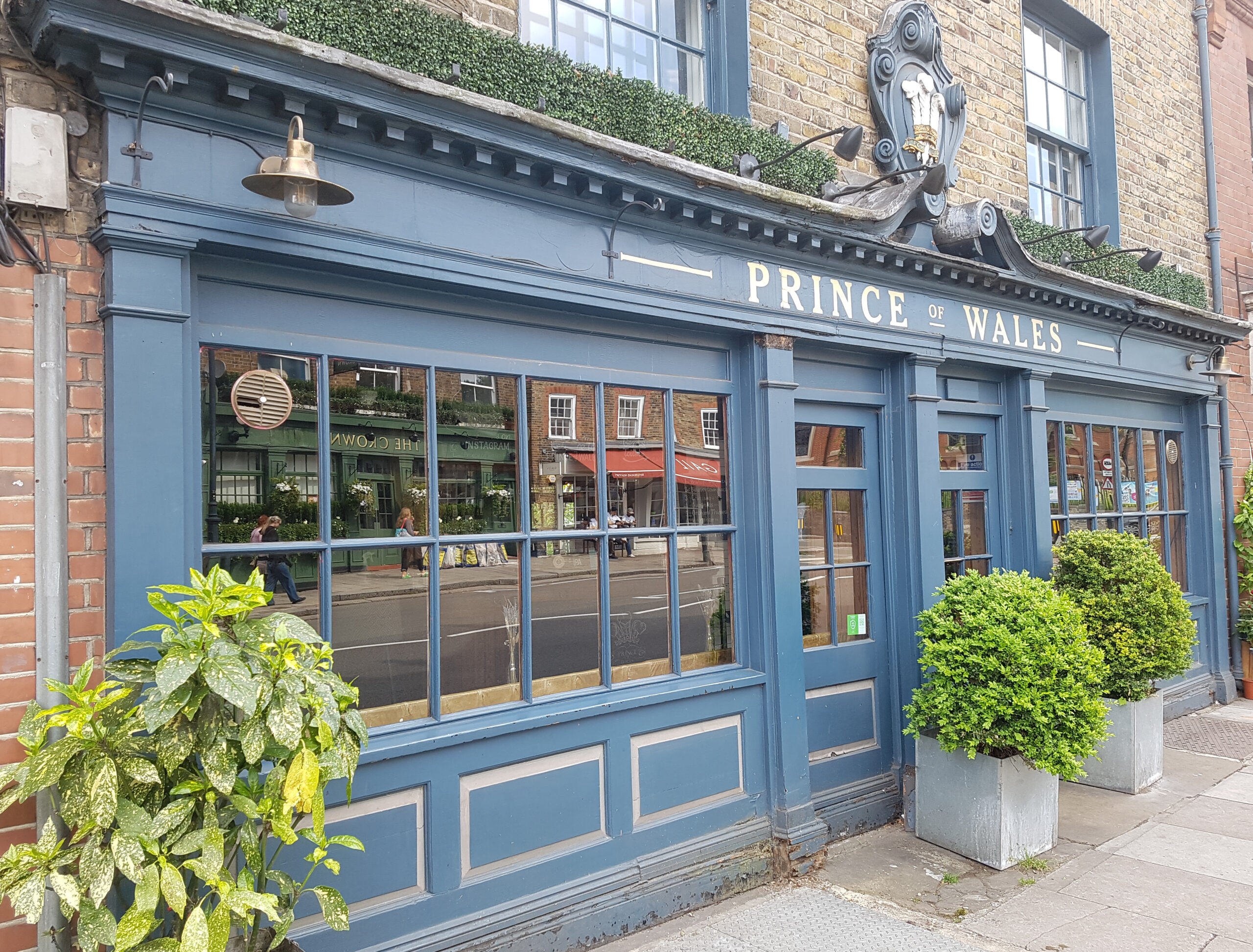
- The Prince of Wales pub was opened in 1864 and named after the Prince who became Edward VII
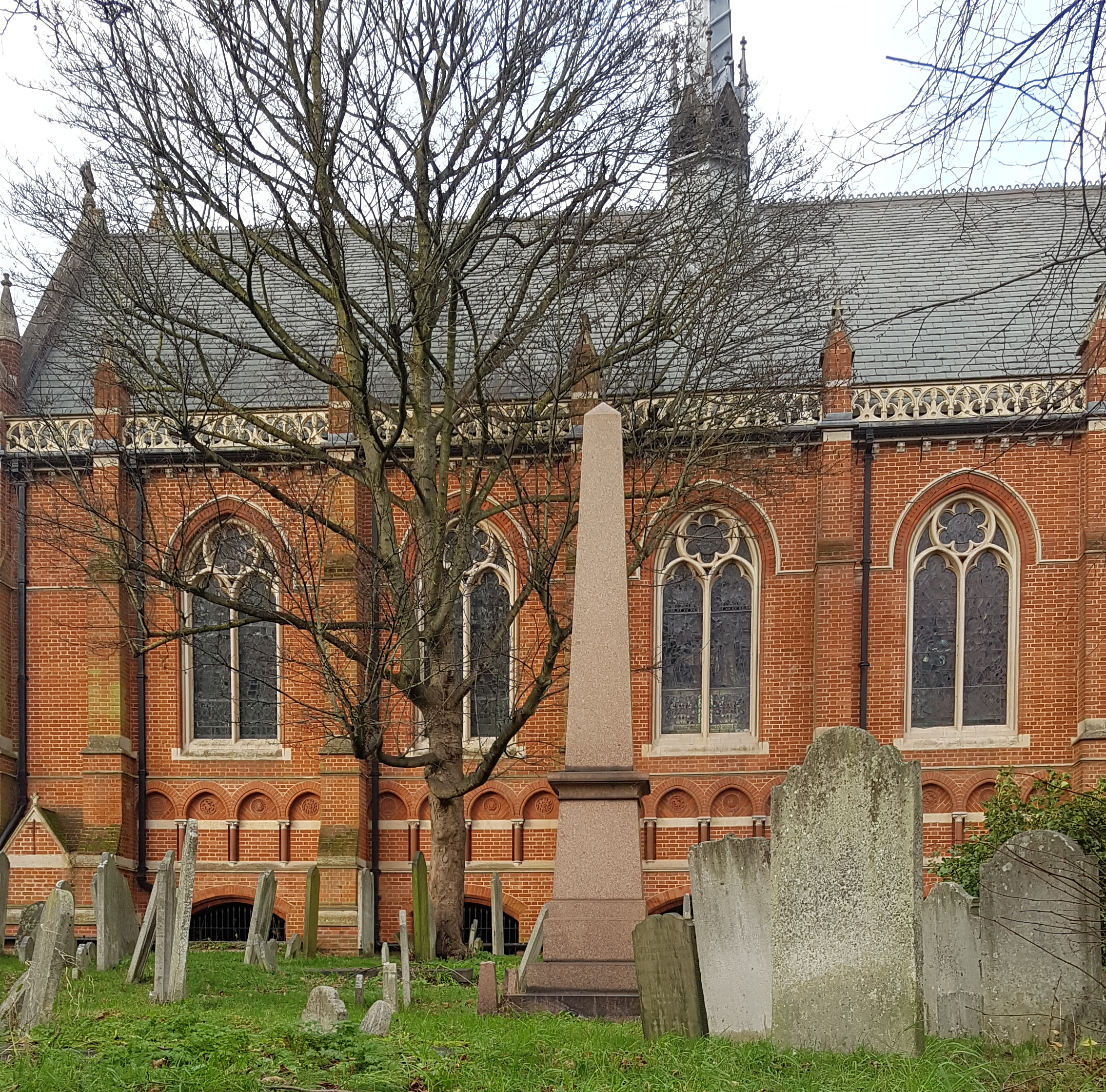
- Forming a rustic gateway to the village, the churchyard was a buriel ground for the Tudor Highgate School Chapel. Designated a ‘Chapel-of-ease’ as the nearest churches were located at St Pancras and Hornsey.

- Until 1902, 49-50 West Hill was the Highgate District police station. The gaol was around the corner in the High Street and is now an Estate Agent.
- Georgian Apothecary House, 47 Highgate West Hill, was the home of several generations of the Wetherells, a family of doctors.
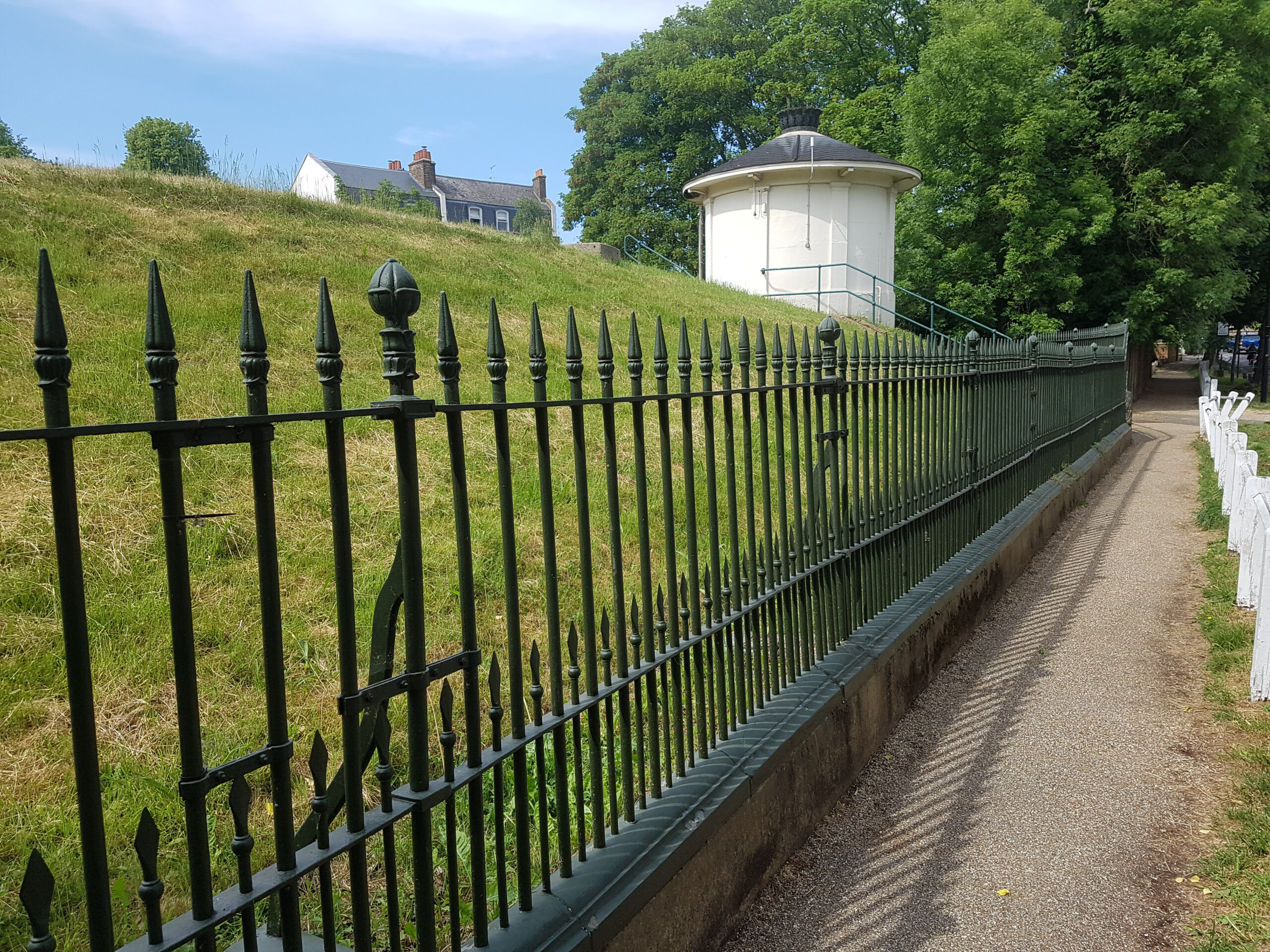
- Highgate Reservoir, built 1854 to provide Highgate’s first water supply. The Listed pump house and railings date from its construction.
- This open grassed area is the last fragment of the once much larger Highgate Green.

- The Flask public house dates from at least 1716; named from the flasks of Spa water it sold. The artist William Hogarth (1697-1764) was a visitor.
- 1-6 The Grove, built c.1700 on the site of the 17th century mansion Dorchester House, is one of suburban London’s most important early 18th century developments. Poet Samuel Taylor Coleridge spent his last years, 1823-34, at No 3 with Dr. James Gillman’s family. Other residents included Leigh Hunt, J.B. Priestley, George Michael, Kate Moss, Jude Law and Yehudi Menuhin.
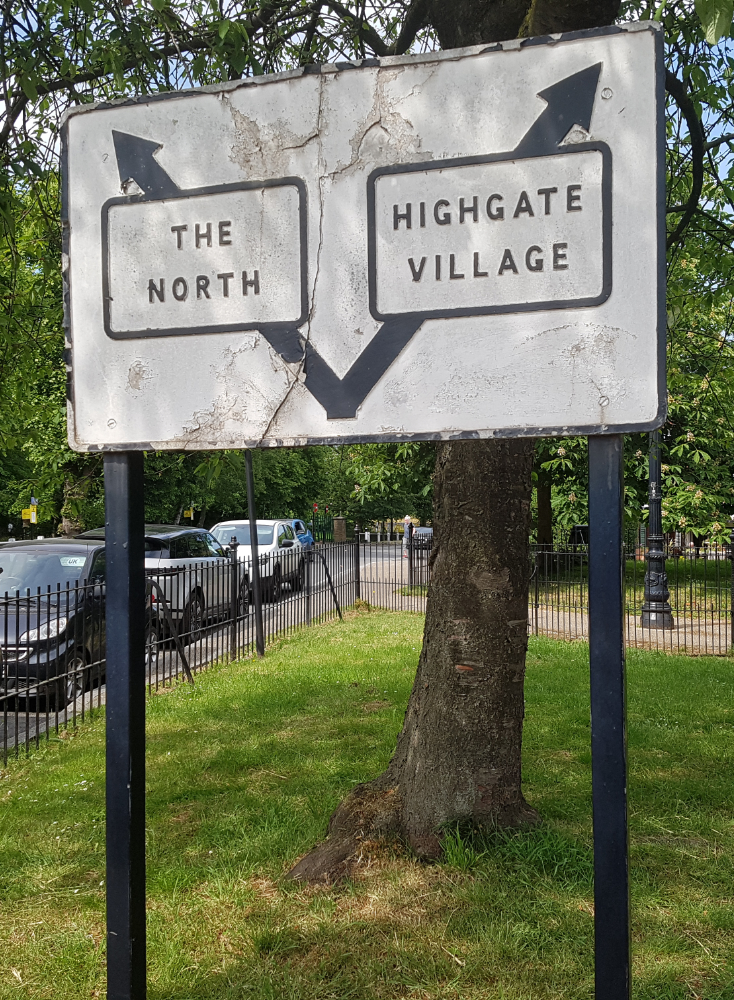
- The sign directing motorists to “The North” and “Highgate Village” is a restored pre-war sign
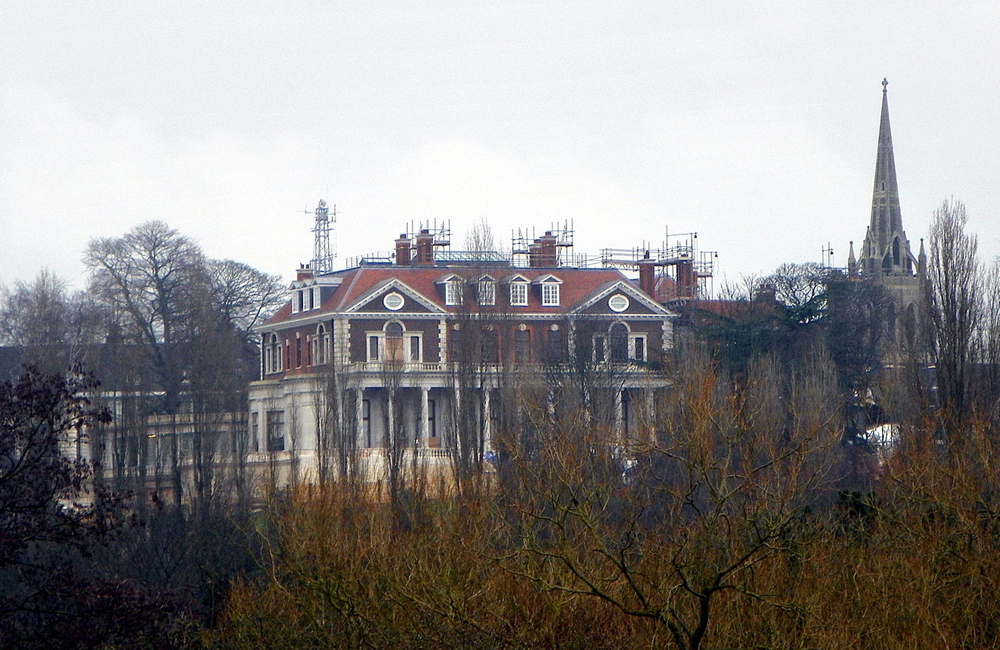
- The 18th century mansion Parkfield was replaced in 1917 by the vast Chateau-style Witanhurst for industrialist Sir Arthur Crosfield, who was instrumental in saving Kenwood House. The largest private house in London after Buckingham Palace, it has recently undergone substantial alteration. Much of the fine gardens were built on in the 1960s despite local opposition.
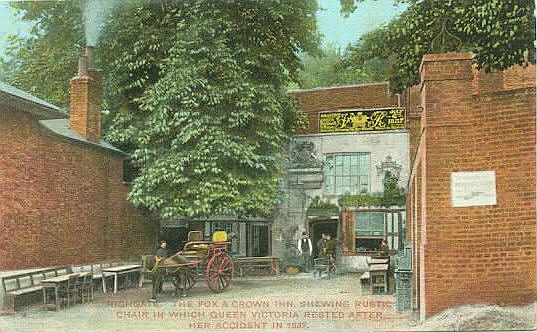
- An inscription on the 1898 building 39-40 Highgate West Hill states “Site of the Old Fox & Crown”, arguably the scene of Highgate’s greatest contribution to world history. In 1837, the young Queen Victoria was travelling down the hill when her horses bolted. The landlord, James Turner, managed to stop the carriage. Had Victoria been killed, there would have been no Victorian era! The inn was demolished in 1896; the royal coat of arms presented to Turner is now in the Highgate Literary and Scientific Institution.
- Holly Terrace, a fine c.1807 row of houses.
- 31 Highgate West Hill, a late Victorian house, was the childhood home of poet John Betjeman (1906-84).
- Holly Lodge Estate, on the site of the 19th century Holly Lodge, home of philanthropist Baroness Angela Burdett-Coutts (1814-1906), the wealthiest woman in England after Queen Victoria. The Estate was sold and developed in the 1920s. Robin Grove, immediately uphill, was originally the entrance.
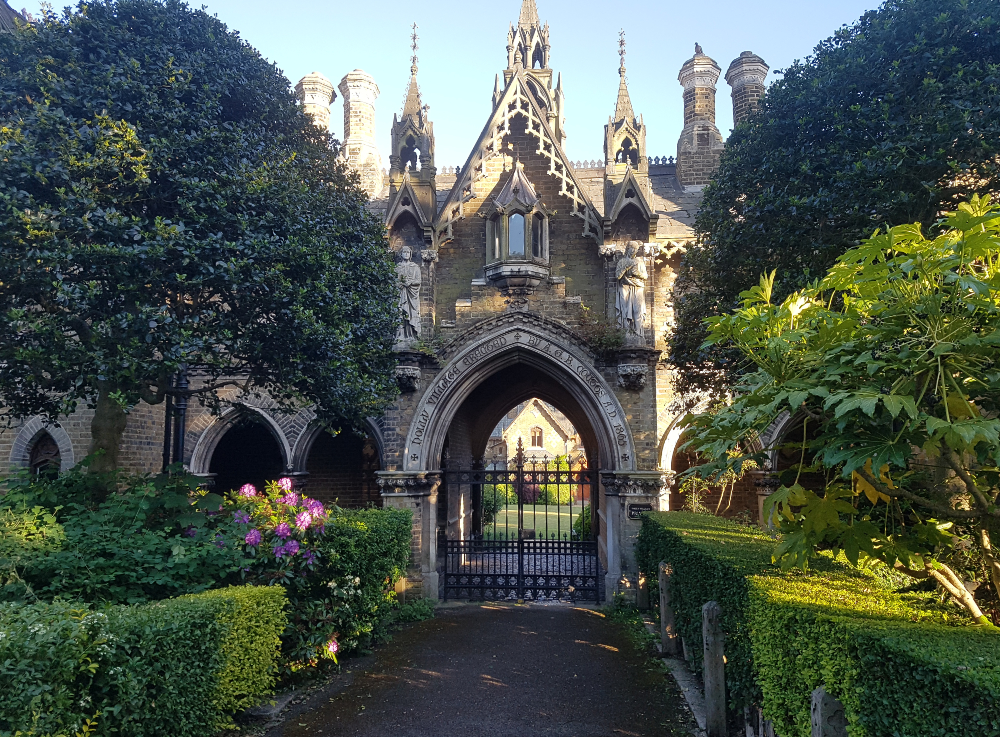
- Holly Village comprises nine ornate Gothic-style cottages, built 1865 by Henry Darbyshire for Baroness Burdett-Coutts as homes for her retired estate workers; today they are desirable residences.
- The important late 16th-18th century Voel House. The early Victorian milestone in front, stating “IV Miles from St. Giles Pound”, should read “V”.
- St. Michael’s Church, by architect Lewis Vulliamy, built 1832 on the site of the 1693-4 Ashurst House. After an 1820s legal dispute, St. Michael’s replaced Highgate School old chapel (see 29) as the village church. The remains of poet Samuel Taylor Coleridge were exhumed from Highgate School chapel in 1961 and reinterred here.
- The workers’ cottages above the stables of The Flask public house, a rare survival, were sensitively restored c.2010.

- The Old Hall (now three houses), probably built 1691 and incorporating parts of the 16th-century Arundel House, owned by Thomas Howard, Earl of Arundel (1586-1646), great patron of the arts. Philosopher and statesman Francis Bacon, Baron Verulam, died here in 1626 from pneumonia contracted while experimenting with preserving food by freezing a chicken in snow. Local legend claims the area is still haunted by the ghost of – the chicken! His name is recalled in nearby Bacon’s Lane.
- The Lawns, 16 South Grove, an award-winning 2000 house by Eldridge Smerin. The gate piers of a Victorian house, occupied by scientific instrument maker Louis Casella, remain.
- Moreton House, 14 South Grove, built 1715, was damaged by fire and restored in the 1990s. Dickens is said to have modelled Steerforth’s home in David Copperfield on this property.
- The United Reform Church, Pond Square (1858).
- Rock House, a fine 1777 house with oriel windows.

- Pond Square, a remnant of Highgate Green. Its two Ponds, created by mediæval gravel digging to surface the High Street. These were backfilled in 1864 as a health risk. Since 1881 it has been a public square and, with its magnificent plane trees, is regarded as the heart of Highgate village. Followers of the paranormal might be able to catch a glimpse of Sir Francis Bacon’s headless chicken!
- Swine Lane was renamed Swain’s Lane by over-sensitive Victorians.
- The Lych Gate at 107 Swain’s Lane, erected in memory of boys from the ‘Highgate Camp’ who died in the April 1918 Zeebrugge Raid during World War I.
- The Communications Mast, erected in 1939 as a television relay, played an important role in the Second World War, disrupting the direction-finding systems of enemy bombers. The original wooden mast was replaced in the 1950s with the steel structure that can be seen today.
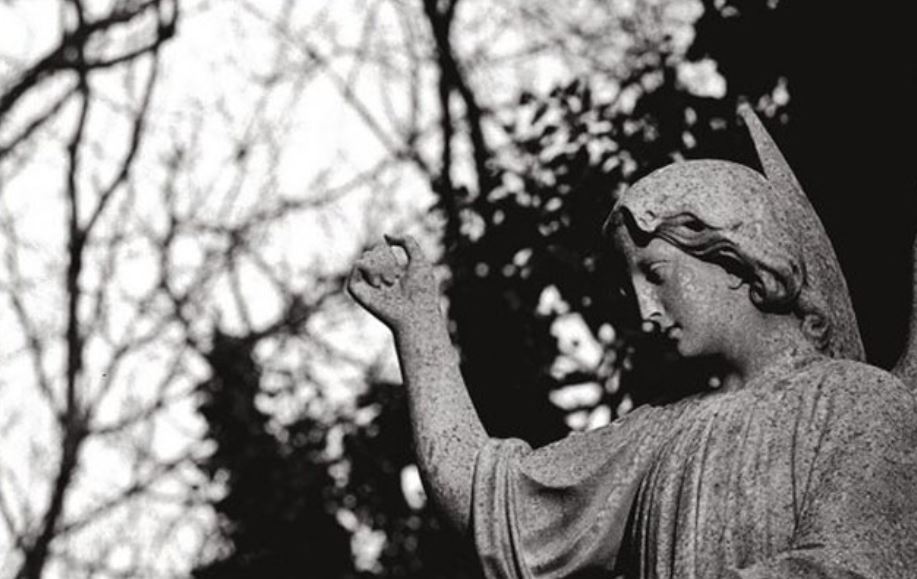
- Highgate Cemetery by architects Stephen Geary & Bunstead Bunning, built 1839 on the site of 17th century Ashurst House. It has over 52,000 graves, many of famous people. These occupants are brought to life by the very informative and entertaining guided tours through the West Cemetery which must be booked in advance. Visitors can stroll through the East side on their own visiting, amongst others, the grave of Karl Marx. Derelict by 1975, it was acquired in 1981 by the Friends of Highgate Cemetery and is now a working cemetery and a major tourist attraction.
- The Gothic building at the lower entrance to Waterlow Park in Swain’s Lane was the entrance Lodge to Sir Sydney Waterlow’s estate (see 12).

- The Highgate Literary and Scientific Institution, founded 1839. Originally one of many, to promote knowledge of the arts, sciences and literature to the working classes, it is now one of only four remaining.

- 10a South Grove, HQ of the Highgate Society, founded in 1966 and one of the country’s largest and most active Civic Amenity Societies. Open 10.30 to 12 on Saturday mornings.
- Church House, 10 South Grove, a fine 18th century building that at one time (c.1802) was home to an early Jewish School for both boys and girls. At the turn of the 20th century, Church House was where a young Harry Beck resided before his entire life was devoted to designing the iconic London Underground map.
- Fitzroy Park, originally the carriage drive to the 1770 Fitzroy House (demolished 1828), now a rustic pedestrian route to Hampstead Heath. Notable buildings include No.6, built by engineer Ove Arup for himself, and The Elms, an 1838-40 mansion by George Basevi.
- Number 1 Hampstead Lane, formerly a motorcycle showroom and restaurant, now serves as the Riverstone Marketing Suite. Exceptional later living apartments for purchase at Fifty-Six, The Bishops Avenue.
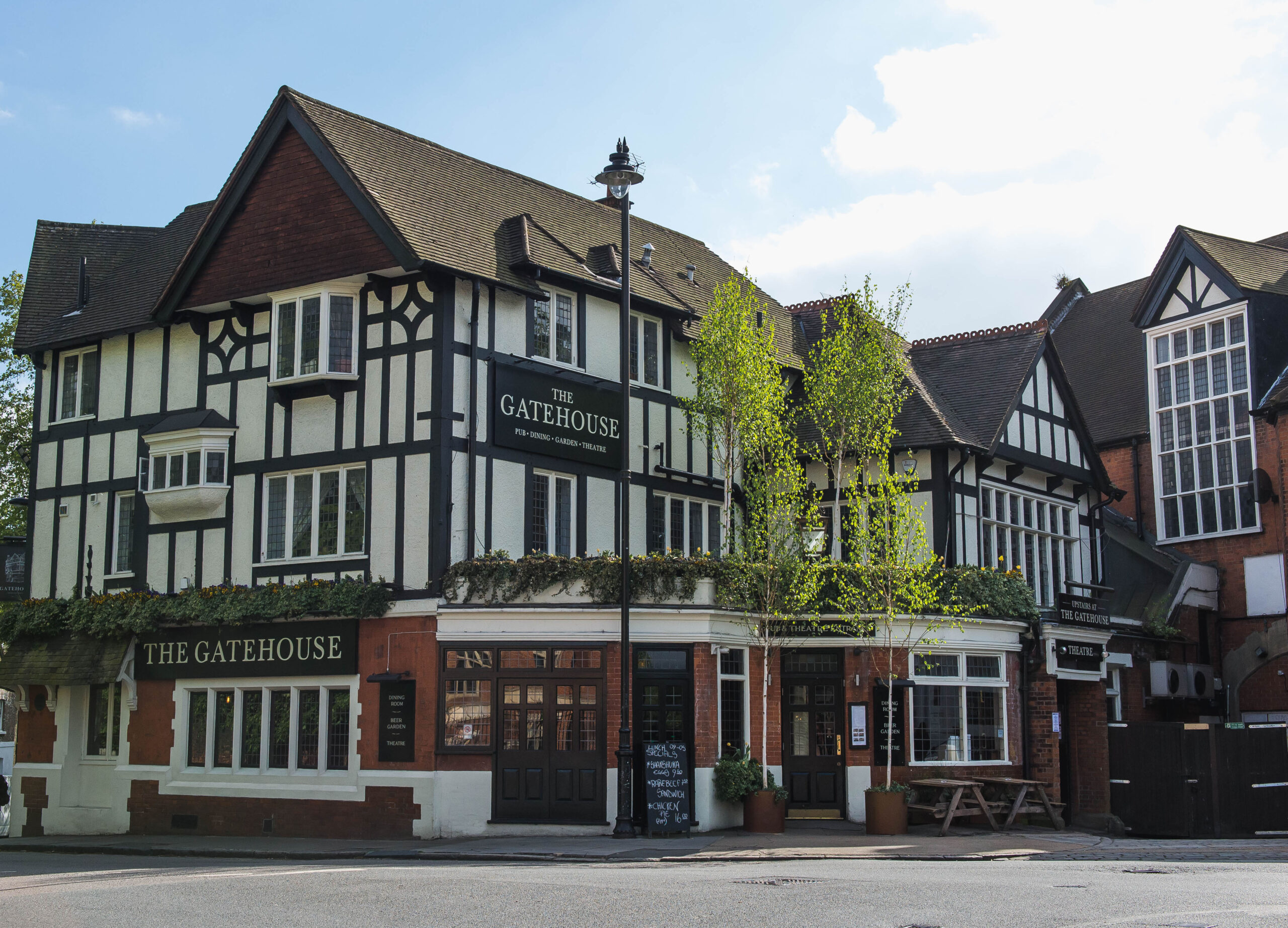
- “Upstairs at the Gatehouse”, a popular local theatre, next to the site of the original High Gate. Originally a Victorian Music Hall, it re-opened as a theatre in 1997. Situated at the highest point (446ft above sea level) of the inner London Boroughs this award winning theatre lives up to its description of ‘London’s Top Theatre’ in more ways than one! Show on Google Map

- The Gatehouse: Originally one of three toll gates into the mediæval Bishops of London’s Hornsey Great Park. An inn since at least 1634. The tollgate was removed in 1876. The name Highgate, first recorded in 1354, probably originated as the “high toll-gate”. Two parish boundary markers are set into its wall; one reads “S[t] P[ancras] P[arish] 1791” and the other “Hornsey Parish 1859”. They recall a time when the boundary between London and Middlesex ran through the inn, and criminals from one administration being tried in the magistrate’s court above the pub could evade justice by crossing the room! The building was remodelled in its current mock-Tudor style in 1905.
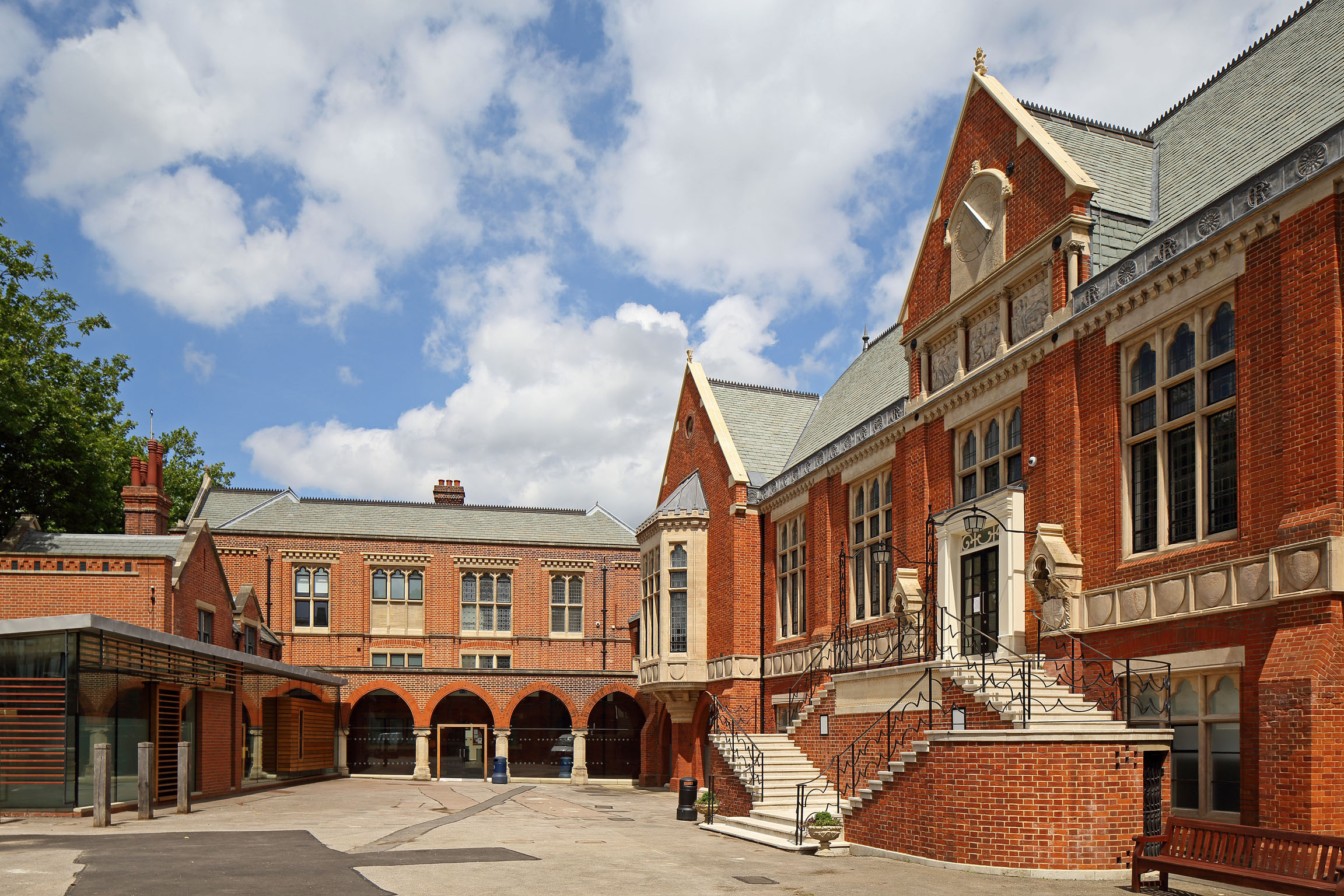
- Highgate School, founded 1565 by Chief Justice Sir Roger Cholmeley; alumni are called Old Cholmeleians. Two other founders were Bishops of London, who donated land from their Park. The block on the left of the main Quadrangle is by C.P.Leach (1898-99). The quaint gate and bell tower is probably the oldest part of the school. The 1867 Big School, now a library, and the Chapel, built 1865 on the site of a Tudor chapel demolished in 1833, are by Frederick Pepys Cockerell. In 1916 T.S.Eliot was a teacher and John Betjeman one of his pupils. Excavations on the site of the Charter Block in 2014 found remains of the kilns producing bricks for the original 1570s buildings. The wrought iron gates in North Road are a war memorial.
- The 1840 Halfway Cottage, formerly a stable, retains the hoist and upper door for grain sacks.
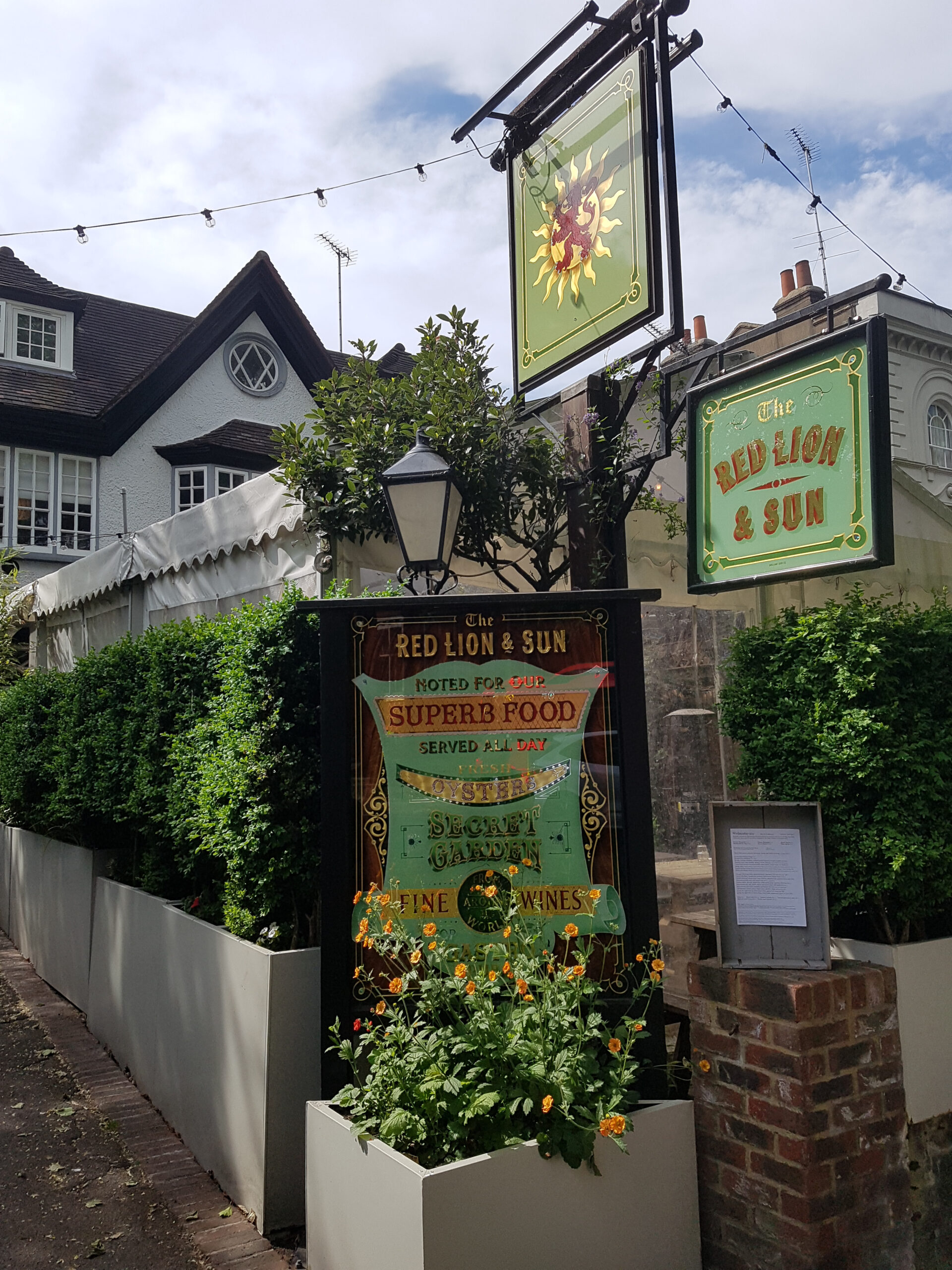
- The Red Lion and Sun was two pubs until 1890 – The Red Lion and the Sun; the building dates to 1928.
- 17 North Road, a fine early 18th century house with possible mediæval origins, was where E.Houseman wrote his celebrated poem “A Shropshire Lad”.
- The Sycamores, 19 North Road, a fine late 17th-early 18th century house, Listed Grade II*.
- The Bell and Horns pub from 1721 until 1925, its forecourt subsequently a petrol station. Note weatherboarded Medlar Cottage to the right.
- 45 North Road, “The Old Forge” was until 1926 the site of Hayhoe’s Forge, there by 1826. It was demolished in 1953 and rebuilt as a house.
- St. Michael’s Church of England Junior School, by architect Anthony Salvin, in Victorian Gothic style, opened in 1859.

- Fire Station Flats / Highgate Shul (Synagogue) The building at the front of 57 North Road recalls its former use as the Hornsey Urban District Fire Station (1894 – 1934). The building at the rear belongs to Highgate’s Jewish community who opened their refurbished Synagogue in September 2016.
- Northfield Hall, in the later 19th century the drill hall for the 3rd Middlesex Rifle Volunteer Corps.
- Castle Yard was once the yard of the Castle, an inn 1719-1872, the Highgate Working Men’s Club until 1880, the Castle Coffee and Dining Rooms until 1920, demolished in 1928. The name may derive from a Civil War-era fortification. The Victorian workers’ cottages, Nos. 1-11, were restored c.2005
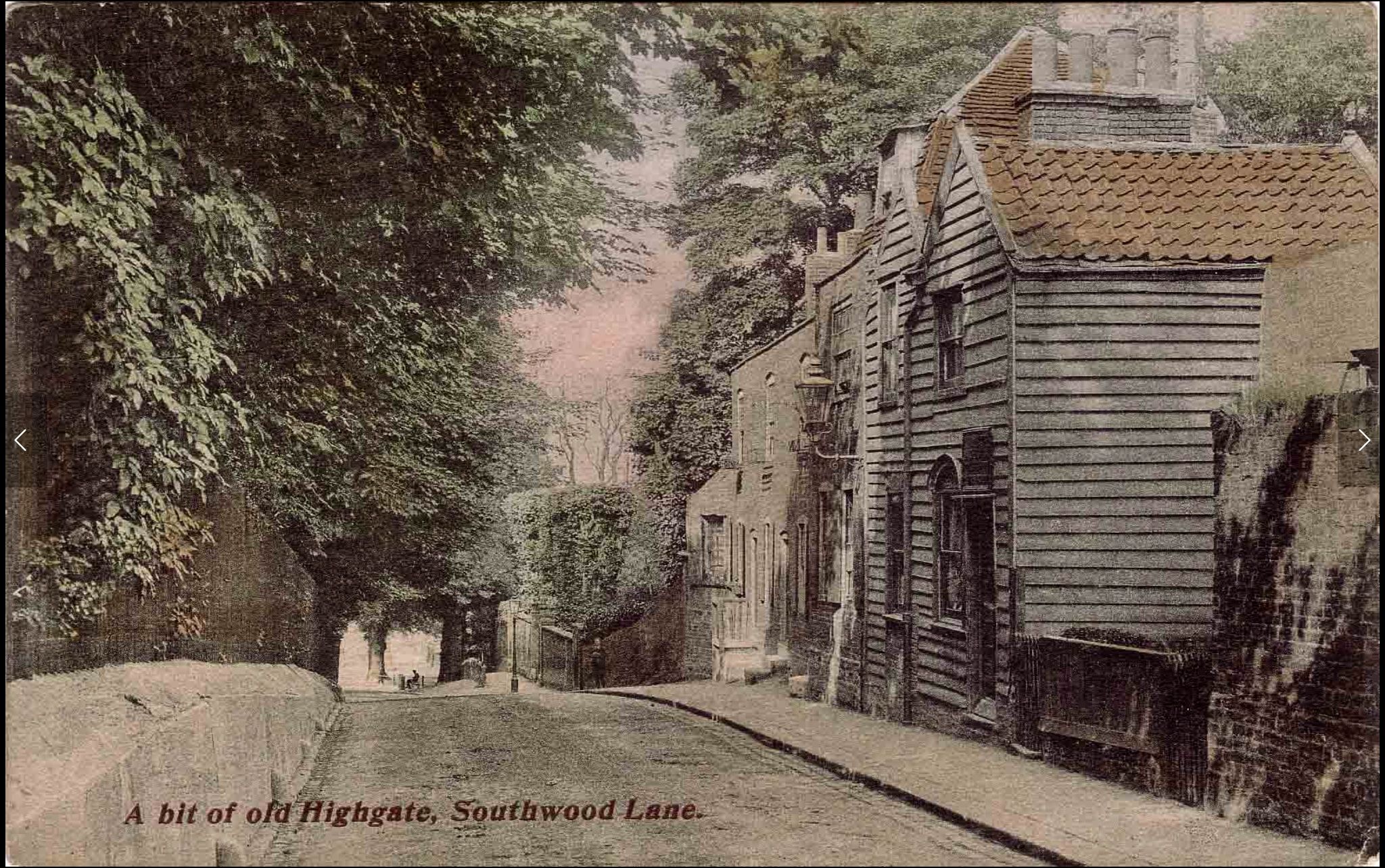
- Southwood Lane, marking the eastern boundary of the Bishops’ Park, has a wide range of architectural styles. The name recalls that it led to Sow Wood, renamed Queen’s Wood for Queen Victoria.
- 1-18 Southwood Lane, a fine row of mainly Georgian town houses.
- Georgian Dyne House, named for Dr. John Bradley Dyne, Headmaster of Highgate School 1838-74, was replaced by its modernist namesake in 1967.
- The Highgate School small Quadrangle and 1928 Science Block.
- Originally a Baptist Tabernacle, built when nonconforming churches were forbidden within a 5-mile radius of Charing Cross. Now the Highgate School meeting hall and Museum, the latter open free of charge on Saturdays during term-time 10-1.

- “Avalon”, 22 Southwood Lane, childhood home of naturalist and African explorer Mary Kingsley (1862-1900). She died of typhoid fever while nursing Boer prisoners of war in South Africa and was buried at sea with full military honours. Her name is commemorated in Kingsley Place.
- The picturesque Almhouses, built by Sir John Wollaston in 1656, rebuilt in 1722 by Sir Edward Pauncefort. The two-storey structure in the middle was once a school for girls.
- Kingsley Place, a 1967 development on the gardens of The Limes and Southwood Lodge by Architects Co-Partnership.
- 92 North Road. A Blue Plaque records that Charles Dickens stayed here in 1832
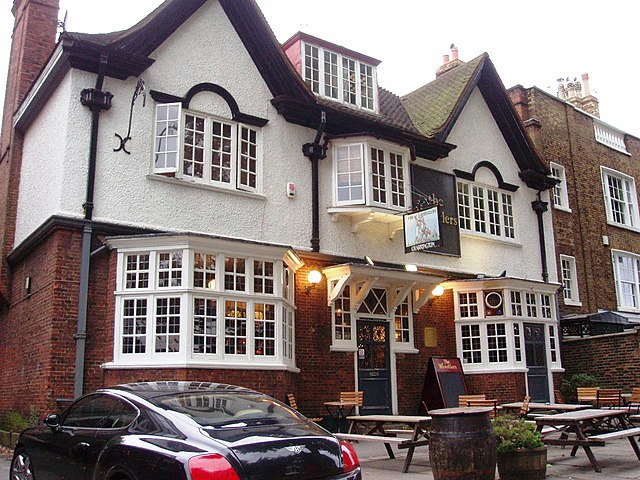
- The Wrestlers, 98 North Road, Highgate’s oldest Public House, traditionally founded in 1547. The present building dates to 1921. Highgate’s renowned, if bizarre, ceremony of “Swearing on the Horns”, established by 18th century publicans to promote trade and mentioned in a poem by Lord Byron, is still occasionally performed here. After swearing a series of harmless oaths, the initiate became a Freeman of Highgate and had the right to take the place of any pig seen resting in a ditch when travelling through the village. The pub keeps an old set of horns (actually deer antlers) for use in the ceremony; sadly, there are few opportunities nowadays to exercise a Freeman’s rights. In 1995 it was re-named The Slug and Lettuce; furious locals quickly got it changed back.
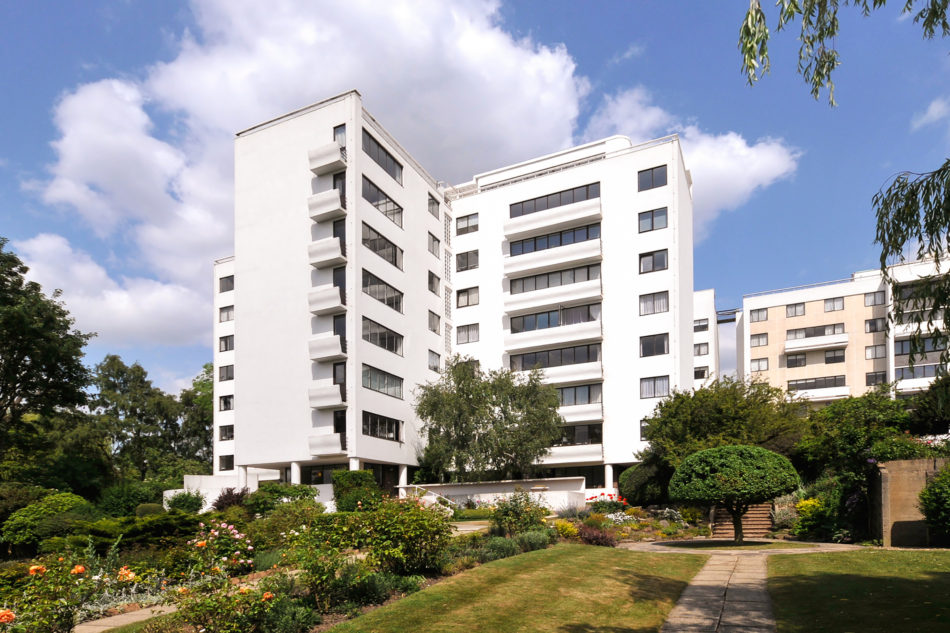
- Art Deco Highpoint, by Lubetkin and Tecton, an iconic example of 1930s British architecture. At the time it aroused fierce opposition from local people who formed the Highgate Preservation Society to oppose “unsightly and unwanted development”. Built on the site of the 18th century house The Cedars, a name recalled by surviving trees.
- North Hill has an impressive range of 17th to 20th century architecture. Get the Highgate Society’s free leaflet, “North Hill, Highgate: The Most Architecturally Diverse Street in Britain?”
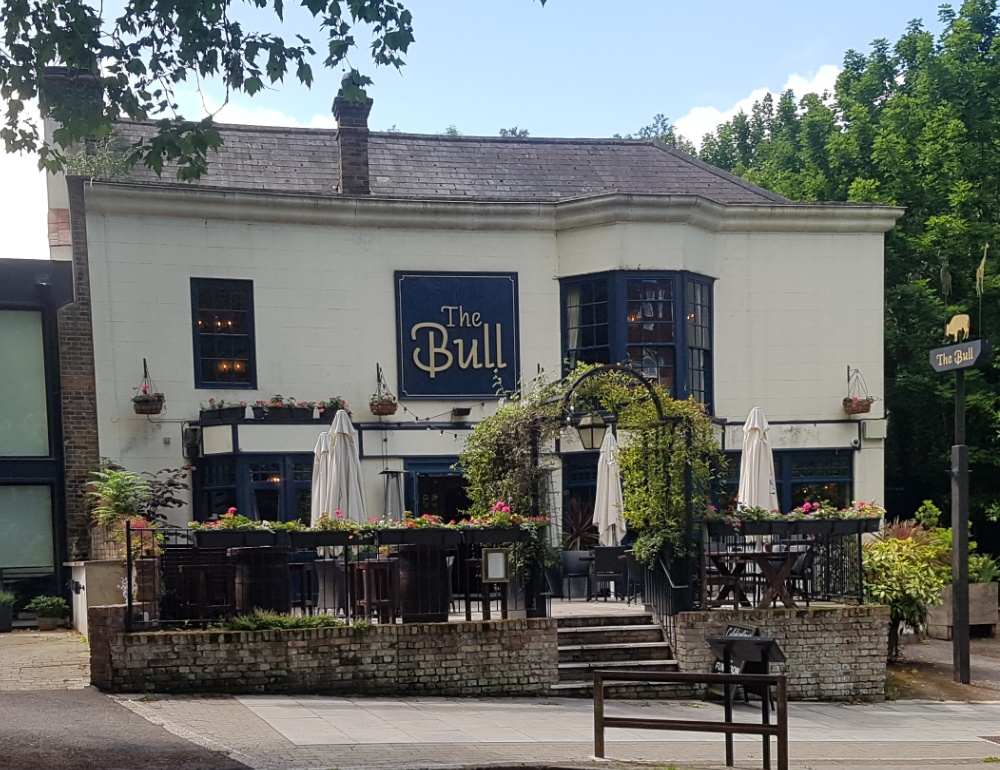
- The Bull, a pub since 1765. Artist George Morland was a regular customer, running up debts which he paid off in paintings.
- In 1856 the 60-acre grounds of Park House became a London Diocesan Reformatory for “fallen women”; the poet Christina Rossetti was involved with it. The site is now the 1949 Hillcrest Estate by T.P.Bennett, the blocks named after British commanders in the Second World War.
- The small green at the junction of North Hill and Park House Passage was until c.1880 the local Cattle Pound. The large Lime Tree behind it sits on what may be a surviving fragment of the western pale of the mediæval Hornsey Little Park.
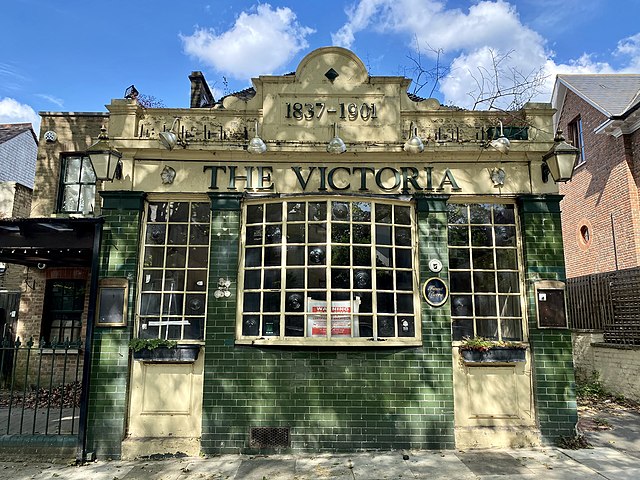
- The Victoria, a pub since at least 1861 and rebuilt in the early 20th century. It closed in 2015.
- All Saints Church, by A.W.Blomfield, built 1864, extended in 1874 and 1912.
- Highgate Wood, a nationally important ancient woodland, saved from redevelopment in 1887 by local politician Henry Reader Williams (commemorated on the Crouch End Clock Tower) and acquired by the City of London. Prehistoric and Roman remains have been found there, and it contains hundreds of ancient coppiced hornbeams. The Roman pottery kiln excavated there in 1968 is now permanently on display as a visitor attraction. https://www.highgateromankiln.org.uk/
- 10 Muswell Hill Road was the teenage home of comedian Peter Sellers, 1936-40.
- Wood Lane has some fine early-mid 19th century buildings.
- Queens Wood, saved from development in the 1880s by Hornsey Council; now run by Haringey. Formerly called Churchyard Bottom Wood, though there is no church anywhere near; local tradition says that Plague victims were buried here, though no evidence has ever been found.
- Priory Gardens, built c.1910 in the grounds of The Priory; when the latter was built in 1832, a hoard of Roman coins was found there.
- The Woodman pub, built for the then-new Archway Road in 1828. Rebuilt in 1905, it is a splendid example of the Arts and Crafts style.
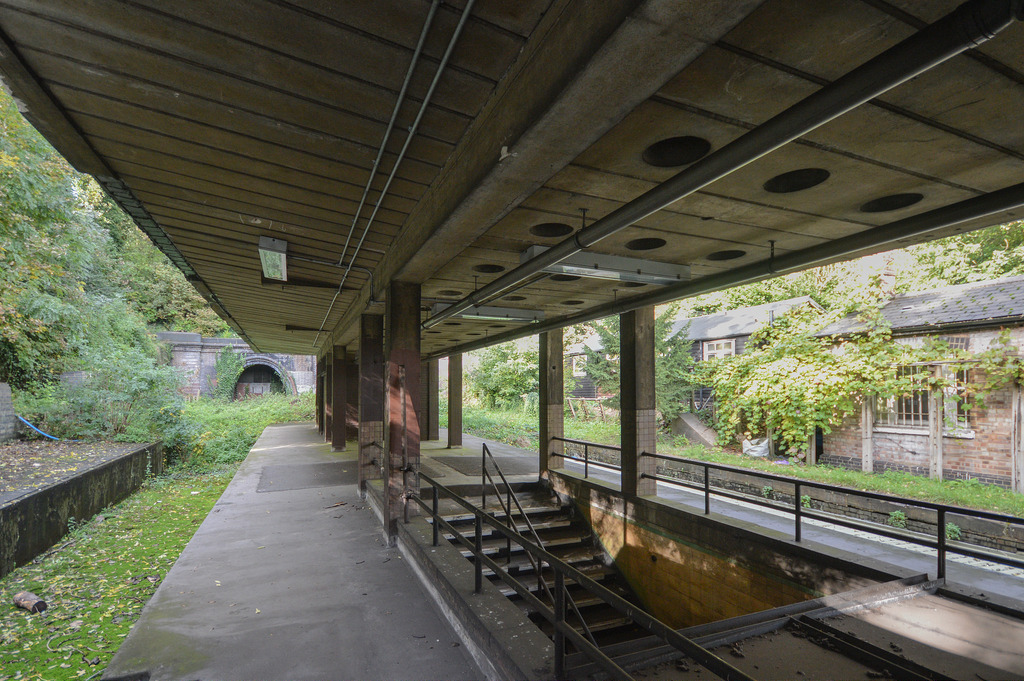
- Highgate Overground Station operated from 1867 until the line closed in 1954; the original station cottage survives. The Underground station opened in 1939. The area is now a Site of Metropolitan Importance for Nature Conservation.
- Grand Parade, between Jackson’s and Southwood Lanes, built c.1898-1905 by W.H.Boney in the Dutch Gabled style.
- When the Pond Square ponds were filled in, it was proposed to build model dwellings for the poor there. Building on a village open space was opposed, so Coleridge Buildings was built here instead in 1867, on the corner of Archway Road and Shepherds Hill. It was destroyed in 1944 by a V-Bomb, and replaced in 1950 by Goldsmith’s Court.
- The Parkland Walk, a pleasant rural and ecological amenity on the line of the former railway from Finsbury Park to Alexandra Palace (closed 1955)
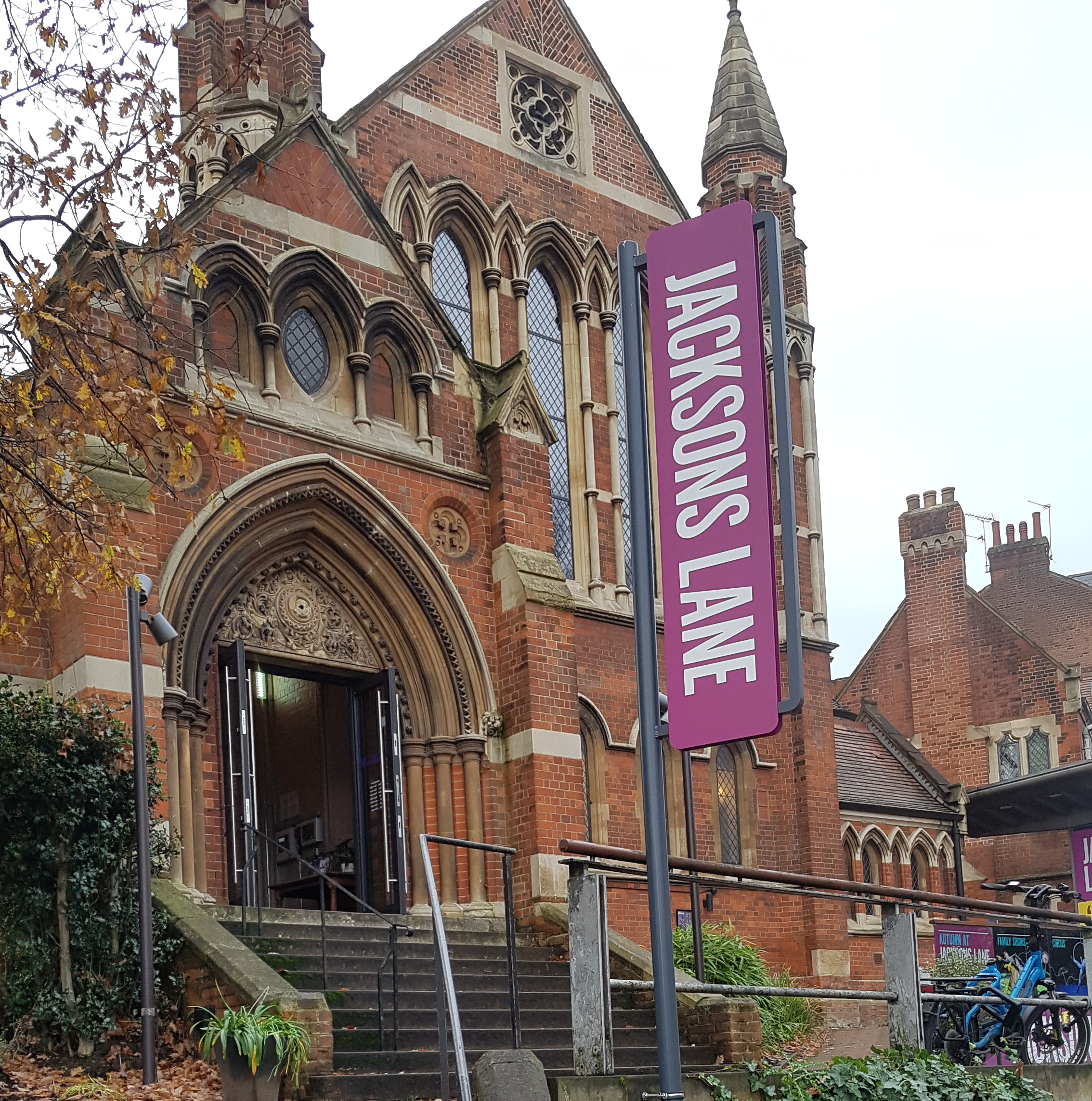
- The 1905 Wesleyan Methodist Church by W.H.Boney, saved from demolition by the Highgate Society, has since 1976 been the home of the Jackson’s Lane Community Centre, a popular local arts venue. In addition to music, drama and comedy, Jacksons Lane regularly features circus skills in its programme of education and events.
- The land bounded by Southwood and Jackson’s Lanes and Hillside Gardens was formerly Southwood, the 1738 mansion of General George Wade, who suppressed the Jacobite Rebellion at the Battle of Culloden Moor in 1745. Destroyed by fire in 1953, it is now a noted 1958 housing development by Andrews, Sherlock, Emerson & Keable; one of its rooms is reconstructed in the Museum of the Home.
- Two bollards mark the former position of the local well.
- Wells Cottage opposite, named for its proximity to the well, is an important late Georgian house; note the early Sun Insurance Company firemark.
- The picturesque c.1800 Bank Point Cottage, at the apex of Southwood Lane and Jackson’s Lane.
- Hillside, an important 18th-century house. From c.1809 to 1815 it was the home of Colonel Joseph P. Jackson, for whom Jackson’s Lane was named, and later of Highgate historian, John Lloyd.
- The 1880 Southwood Court was demolished in 1965 to make way for Southwood Park, a large block by Douglas Stephens & Partners. Its former entrance, on Southwood Lane, bears the crest of John Grove Johnson, who lived there 1880-1908.
- The Arts and Crafts Church of St. Augustine of Canterbury, by J.D.Sedding and J. Harold Gibbons, 1885-1916.
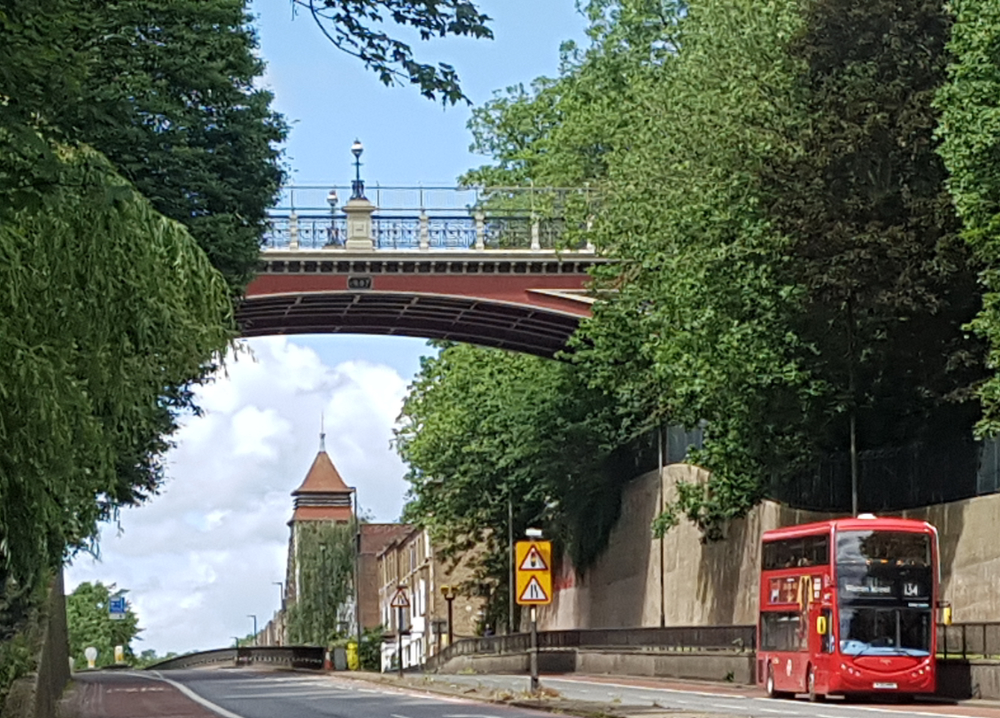
- The Highgate Archway Company was formed in 1808 to build a by-pass to Highgate Hill, impassable in winter for horsedrawn vehicles. A tunnel beneath Hornsey Lane collapsed in 1813, and the plan changed to a cutting, with Hornsey Lane carried on a stone bridge by architect John Nash and engineer John Rennie. In 1900 it was replaced by Sir Alexander Binnie’s fine cast iron bridge; the date 1897 commemorates Victoria’s Jubilee, not its construction.
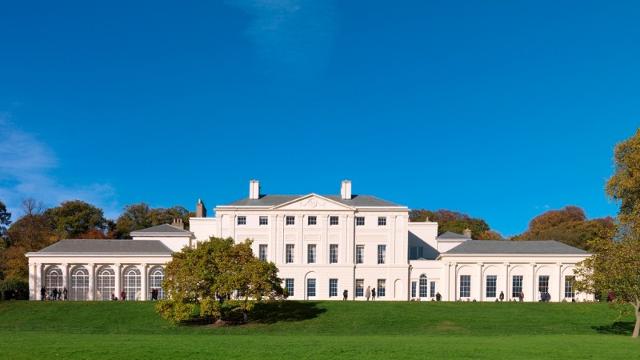
- Kenwood House, built 1764-79 by Robert Adam for the 1st Earl of Mansfield, whose decision, in the 1771 Somerset case, was an important step towards the abolition of slavery in the British Empire. Threatened with development in the 1920s, it was bought in 1925 by Edward Cecil Guinness, 1st Earl of Iveagh, and donated to the public. It is now managed by English Heritage. The magnificent house, priceless art collection and 74-acre estate are open free of charge; see their website for opening times.
- Athlone House, a fine 1870s mansion, was a cause célèbre as local groups fought to prevent developers demolishing it. Their 18-year battle was crowned with success in 2015, and it has been repaired and restored by its current owners.
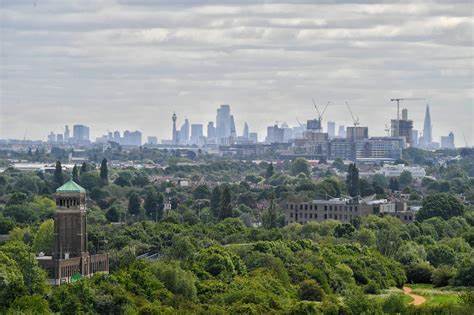
- Hampstead Heath, London’s best-loved open space. A relic of Middlesex countryside, its 320 hectares of fields, woods and ancient hedgerows are a haven for wildlife. There are cafes, playgrounds, events and sporting facilities. Outdoor Hampstead Summer Concerts feature music from a wide variety of genres including rock, pop, folk, jazz, classical and opera. Show on Google Maps
- The Gaskell estate (Gaskell, Kenwood, Storey and Yeatman Roads) is a well preserved example of early 20th century public housing by Hornsey Borough, 1902-13
Information accurate as of June 2025
